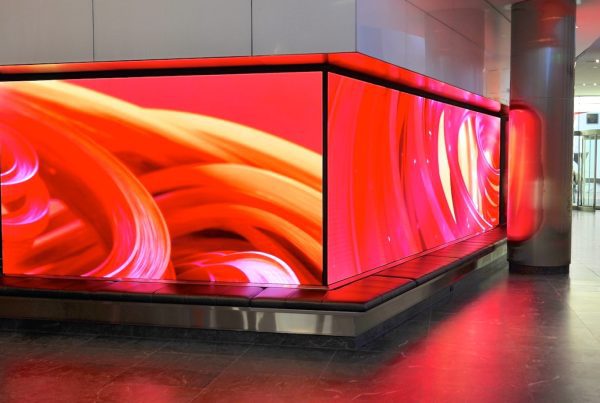10 Mind-blowing facts about Ultra High Definition (UHD)
Screen technology is advancing rapidly, with the latest generation of TVs offering resolutions well surpassing the 1080p standard.
Ultra-high definition represents the next step beyond traditional HDTV, with manufacturers now making Ultra HD 4K displays in a variety of types, such as LED LCDs, OLEDs, QLEDs, and MicroLEDs.
Here are some basic details:
- LED LCDs cover a vast majority of TVs on the market.
- OLEDs are known for deeper blacks and individual pixel illumination.
- QLEDs are Samsung’s version of quantum-dot LED TVs. They emphasize color accuracy and brightness.
- MicroLEDs are an emerging technology with self-emissive microscale LEDs (no need for a backlight or color filter).
Keep reading to learn 10 mind-blowing facts about this incredible technology!
1. 8K UHD offers 16 times the resolution of FULL HD
There are two basic types of ultra-high definition—4K UHD and 8K UHD.
4K UHD: This has a resolution of 3840 x 2160 pixels. It’s often simply referred to as “4K,” though technically, in the cinema industry, 4K is defined as 4096 x 2160 pixels.
8K UHD: This offers an even higher resolution of 7680 x 4320 pixels, which is an incredible sixteen times the resolution of Full HD (1920 x 1080 pixels).
2. UHD’s HDR unlocks a billion colors for unparalleled realism!
UHD displays can reproduce a color gamut much closer to the range perceived by the human eye. This applies specifically to UHD TVs equipped with High Dynamic Range (HDR), as these can produce brighter whites, darker blacks, and a billion or more color variations.
Just as a point of emphasis, there is a difference between UHD 4K and 4K High Dynamic Range.
While UHD 4K focuses on the number of pixels and image sharpness, 4K HDR is more concerned with the quality, depth, and range of colors and contrasts.
Often, modern TVs will offer both UHD 4K resolution and HDR capabilities.
3. Some UHD screens use nanometer-sized Quantum Dot technology
Quantum Dots are extremely small semiconductor particles that allow QLEDs to achieve color accuracy and brightness beyond traditional HD TVs.
TVs labeled as QLEDs utilize Quantum Dot technology in conjunction with LED backlighting.
4. The world’s smallest 4K UHD display is only 9.6 inches
Display technology has witnessed astounding achievements in the last number of years, with one of them being the world’s smallest 4K UHD display, which measures just 9.6 inches!
This small screen packs the same 3840 x 2160 pixels you’d find in larger screens, offering a jaw-dropping pixel density that makes images very sharp and vivid.
At 458ppi, the 9.6-inch 4K display surpasses the limits of the human eye, which is ideal for medical tools and professional video equipment.
Imagine holding near-immaculate clarity and detail in the palm of your hand!
5. UHD enables more realistic virtual reality!
UHD isn’t limited to just TVs and monitors. It’s revolutionizing the world of virtual reality (VR). With UHD resolutions in VR headsets, immersion is reaching new heights, and in some cases, it is blurring the line between the digital and the real.
Moreover, enhanced resolution in VR is aiding fields like medicine, where surgeons use VR simulations for training, ensuring greater precision and detail than ever before.
Please note that YAHAM does not offer virtual reality products. We specialize in the following:
- UHD small pixel pitch displays (as small as 0.9 millimeters. A smaller pitch means a higher pixel count)
- Indoor fixed digital LED displays
- Digital billboards
- Outdoor digital mesh window displays (see-through)
- Rental and staging (Stadiums, arenas, and more)
- More!
See our Applications page for more information.
6. UHD is the future of remote learning and collaboration
As more people transition to working remotely and taking online courses, UHD offers a much-needed solution. With its ultra-clear resolution, educators and professionals can share anything from complex diagrams to microscopic images.
While remote education has experienced some setbacks due to technological gaps and resource limitations, we expect the gap between remote learning and real-world learning to close as screen technologies continue to improve.
7. UHD screens offer viewers a near-microscopic perspective!
Did you know that UHD screens are so fine-tuned that individual pixels are practically invisible to the naked eye? This means you can sit closer to larger UHD screens without seeing the grid-like structure of individual pixels, a phenomenon referred to as the “screen door effect” in lower-resolution screens.
UHD screens offer an astonishing 8 million pixels minimum, compared to the 2 million of Full HD. Such technological sophistication was once limited to specialized domains like professional graphics work or high-end cinema but now has moved to home TVs.
8. UHD offers high-quality slow-motion replays
UHD, when combined with high frame rates (HFR) like 120fps or 240fps, results in exceptionally detailed slow-motion playback. This is because UHD resolution pushes data throughputs at a much higher rate than 1080p HD when recording at 120fps.
The immense data flow allows for the retention of more detail in each frame during slow-motion playback, ensuring that rapid movements, which could easily become a blur in standard HD, are rendered in stunning clarity in UHD.
For sports enthusiasts, this allows for an incredible frame-by-frame analysis of pivotal moments.
9. UHD cinematography has transformed the movie industry
UHD captures details so intricately that filmmakers now have to adjust makeup, costumes, and sets to meet the new standard. This is especially evident in genres like science fiction and fantasy, where UHD brings out the most intricate details in CGI and special effects.
Moreover, the post-production process is undergoing a transformation. Color grading, a vital phase in post-production, now has a broader spectrum to work with, allowing for richer and more vibrant scenes.
This means that CGI models need higher polygon counts and more detailed texture maps. Practical effects, such as prosthetics and miniatures, also need to be crafted with even greater attention to detail.
10. UHD screens can enhance lower-resolution content
UHD screens don’t just work for native UHD content. They can also upscale lower-resolution content. The result? Even your old DVDs or non-4K streams can look sharper and more detailed than you’ve ever seen them before.
The way it works is that UHD TV detects a lower-resolution input (like 1080p content) and then uses algorithms to fill in the missing pixels and adjust the image.
Is UHD 4K better than QLED?
Comparing UHD 4K to QLED is basically comparing apples to oranges. They aren’t equivalent since UHD 4K refers to a screen’s resolution, while QLED is about the colors a TV can produce.
In QLED TVs, Quantum Dots (semiconductor particles that change color based on their size) are placed between a LED backlight and the display panel to produce more saturated and accurate colors.
A QLED TV can be 1080p, UHD (4K), or even 8K in terms of resolution.
Although UHD 4K and QLED are fundamentally different, if you are deciding between a UHD TV and a UHD QLED TV, the latter will likely offer better color performance because of the quantum dot technology.
What about OLED? Is UHD 4K better than OLED?
This question is another comparison of resolution (UHD 4K) and display technology (OLED).
A UHD 4K TV has a resolution of 3840 x 2160 pixels. This doesn’t speak to the type of panel or the technology behind the display—only the resolution.
OLED (Organic Light Emitting Diode), meanwhile, is a type of display made from organic materials that emit light when electricity is applied.
OLED TVs can come in various resolutions, including UHD 4K.
A UHD 4K OLED TV, for example, would be a TV that combines the benefits of high resolution with the perks offered by OLED technology.
If you’re asking whether an OLED TV is better than a standard LED TV at the same UHD 4K resolution, many would argue that the OLED TV offers superior picture quality due to its ability to produce perfect black colors.
Get in Touch with YAHAM!
Yaham, a global leader in signage, began as an LED research and development hub. Now, we’re a major player in signage design, manufacturing, and management, with projects in 112 countries and 50,000 successful installs.
Our LED signs offer longevity, vibrant and clear images, and energy efficiency.
Yaham is headquartered in China’s “Silicon Valley” (Shenzhen) and operates an expansive UL certified facility, ensuring streamlined and professional service.
We manufacture our own products to ensure excellent quality and results for our clients.
» MORE: Yaham’s turn key solutions




